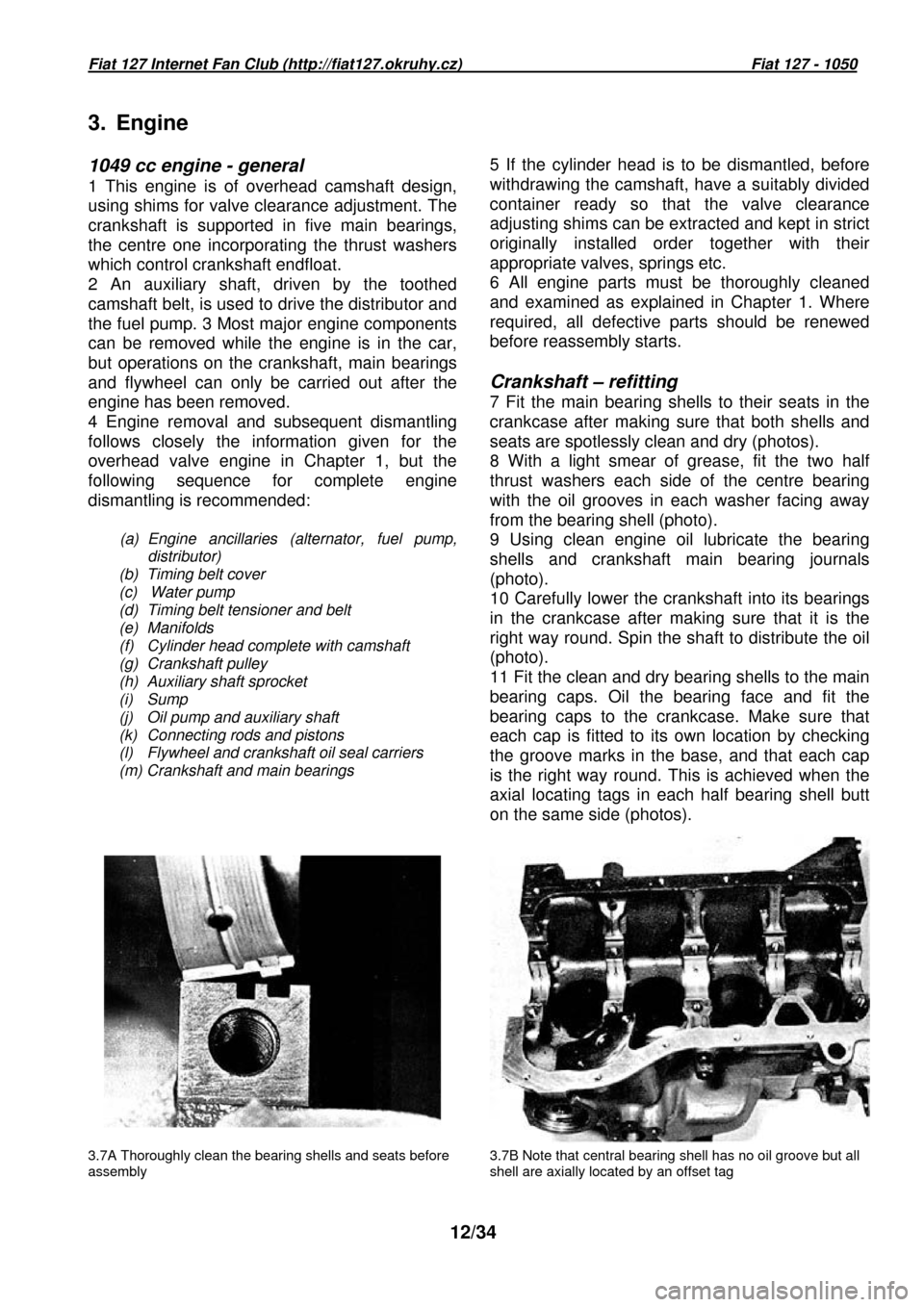seat adjustment FIAT 127 1972 1.G Workshop Manual
[x] Cancel search | Manufacturer: FIAT, Model Year: 1972, Model line: 127, Model: FIAT 127 1972 1.GPages: 34, PDF Size: 6.87 MB
Page 12 of 34

Fiat 127 Internet Fan Club (http://fiat127.okruhy.cz) Fiat 127 - 1050
12/34
3. Engine
1049 cc engine - general
1 This engine is of overhead camshaft design,
using shims for valve clearance adjustment. The
crankshaft is supported in five main bearings,
the centre one incorporating the thrust washers
which control crankshaft endfloat.
2 An auxiliary shaft, driven by the toothed
camshaft belt, is used to drive the distributor and
the fuel pump. 3 Most major engine components
can be removed while the engine is in the car,
but operations on the crankshaft, main bearings
and flywheel can only be carried out after the
engine has been removed.
4 Engine removal and subsequent dismantling
follows closely the information given for the
overhead valve engine in Chapter 1, but the
following sequence for complete engine
dismantling is recommended:
(a) Engine ancillaries (alternator, fuel pump, distributor)
(b) Timing belt cover
(c) Water pump
(d) Timing belt tensioner and belt
(e) Manifolds
(f) Cylinder head complete with camshaft
(g) Crankshaft pulley
(h) Auxiliary shaft sprocket
(i) Sump
(j) Oil pump and auxiliary shaft
(k) Connecting rods and pistons
(l) Flywheel and crankshaft oil seal carriers
(m) Crankshaft and main bearings
5 If the cylinder head is to be dismantled, before
withdrawing the camshaft, have a suitably divided
container ready so that the valve clearance
adjusting shims can be extracted and kept in strict
originally installed order together with their
appropriate valves, springs etc.
6 All engine parts must be thoroughly cleaned
and examined as explained in Chapter 1. Where
required, all defective parts should be renewed
before reassembly starts.
Crankshaft – refitting
7 Fit the main bearing shells to their seats in the
crankcase after making sure that both shells and
seats are spotlessly clean and dry (photos).
8 With a light smear of grease, fit the two half
thrust washers each side of the centre bearing
with the oil grooves in each washer facing away
from the bearing shell (photo).
9 Using clean engine oil lubricate the bearing
shells and crankshaft main bearing journals
(photo).
10 Carefully lower the crankshaft into its bearings
in the crankcase after making sure that it is the
right way round. Spin the shaft to distribute the o il
(photo).
11 Fit the clean and dry bearing shells to the main
bearing caps. Oil the bearing face and fit the
bearing caps to the crankcase. Make sure that
each cap is fitted to its own location by checking
the groove marks in the base, and that each cap
is the right way round. This is achieved when the
axial locating tags in each half bearing shell butt
on the same side (photos).
3.7A Thoroughly clean the bearing shells and seats
before
assembly 3.7B Note that central bearing shell has no oil gro ove but all
shell are axially located by an offset tag
Page 29 of 34

Fiat 127 Internet Fan Club (http://fiat127.okruhy.cz) Fiat 127 - 1050
29/34
78 Slacken the tensioner bolts to tension the belt
and retighten the bolts (photo).
79 Turn the engine over for two complete
revolutions to even out belt tension. Then again
slacken the tensioner bolts to let the tensioner
take up any slack and
retighten the bolts. Never
turn the engine backwards or rock the camshaft
when tensioning the belt, as slack could develop
in the belt and it might jump a tooth.
80 Refit and tension the alternator/water pump
V-belt. Refit the drivebelt cover.
Valve clearances - adjustment
81 Checking the valve clearances should be
done at the 6000 miles servicing, or whenever
the cylinder head has been removed and
refitted for any reason. It is important that the
clearances are set correctly, otherwise the
timing will be wrong and the engine
performance will be poor. If there is no
clearance at all, the valves and seats will soon
get burnt. Set the clearances with the engine
cold.
82 Remove the camshaft cover. The engine can
be turned over by either using a spanner on the
crankshaft pulley nut, or by jacking up a front
wheel, engaging top gear and using the wheel
to turn the engine.
83 Each tappet must be checked when its
operating cam is pointing upwards, 1800 away
from the tappet. Check the clearances in the
firing order, No. 1 cylinder first and then 3, 4
and 2. Do the exhaust of one cylinder and the
inlet of the one after, at the same time to
minimise the amount of engine turning. Counting
from the timing belt end, exhaust valves are
1-4-5-8, inlet valves 2-3-6-7.
84 Insert the feeler gauge for the appropriate
valve. See the Specifications for correct
settings. The feeler should slide in readily
between cam and shim, but with slight frictional
drag. Try one a size thicker and one a size
thinner. The thick one should not go in and the
thinner one should be too loose (photo).
85 If the clearance is wrong, measure the
clearance and write it down with the number of
the valve. When all the clearances have been
checked, it will be necessary to remove those
shims which are fitted where the clearances are
wrong, and renew them with different thickness
shims. If a clearance is too big, use a thicker
shim. If a clearance is too small use a thinner
shim. Calculate by simple subtraction. 86 To change a shim, turn the engine until the
relevant cam is pointing upwards, then turn the
tappet in its housing so that the slot in the rim is
accessible.
87 The manufacturer provides special tools for
depressing tappets (Nos. A60480 and A60443).
These make the job easier if they can be
borrowed, but it is possible to do the job without
them. The best way is to make up a tool from a
piece of steel plate shaped as shown in the
photograph. Alternatively use a screwdriver to
lever the tappet down and another on
e, on edge,
to hold the tappet down by positioning it
between the camshaft and the rim of the tappet;
then remove the lever. This is quite tricky and
needs some care to avoid any damage. If in any
doubt about doing this job it should be left to a
FIAT agent. As well as having the right tools he
will also have a stock of shims from which to
choose those required to correct wrong
clearances. It is expensive buying shims that are
not required (photo).
88 With the tappet held down, prise the shim out
with a thin screwdriver. The FIAT way is to lift
the shim using compressed air, which is
effective if an air line is available. The shims are
held in quite strongly by the oil film and they
must be lifted up square or they will jam.
Remove the shim with long-nosed pliers
(photos).
89 When new, shims have their thickness
marked in millimetres on their undersides. This
marking may wear off and then it will be
necessary to measure their thickness with a
micrometer. From the thickness of the shim and
the error in the clearance, calculate the size of
shim required to produce the correct clearance.
90 Insert the new shim, numbered side down
towards the tappet. Remove the tools used for
depressing the tappet and repeat the operation
until all clearances are correct.
91 Using clean engine oil lubricate all moving
and sliding parts in the camshaft/tappet
assembly. Fit a new gasket and refit the
camshaft cover together with the nine bolts and
washers. Tighten the bolts progressively (photo).
Engine - final assembly
92 Completing assembly of the 1049 cc engine
follows broadly the procedure for that of the
smaller engine which is dealt with in Chapter 1,
Section 56.
93 The manifold gasket is supplied in two parts
for the 1049 cc engine (photo). These serve